When you think of a kangaroo, you probably think of a large marsupial in Australia that hops along the ground. However, there’s also a smaller, closely related animal called a tree kangaroo.
Both kangaroos and tree kangaroos are macropods, a family of herbivorous marsupials that also includes wallabies. Tree kangaroos live in the rainforests of Indonesia, Papua New Guinea, and the northern area of Queensland.
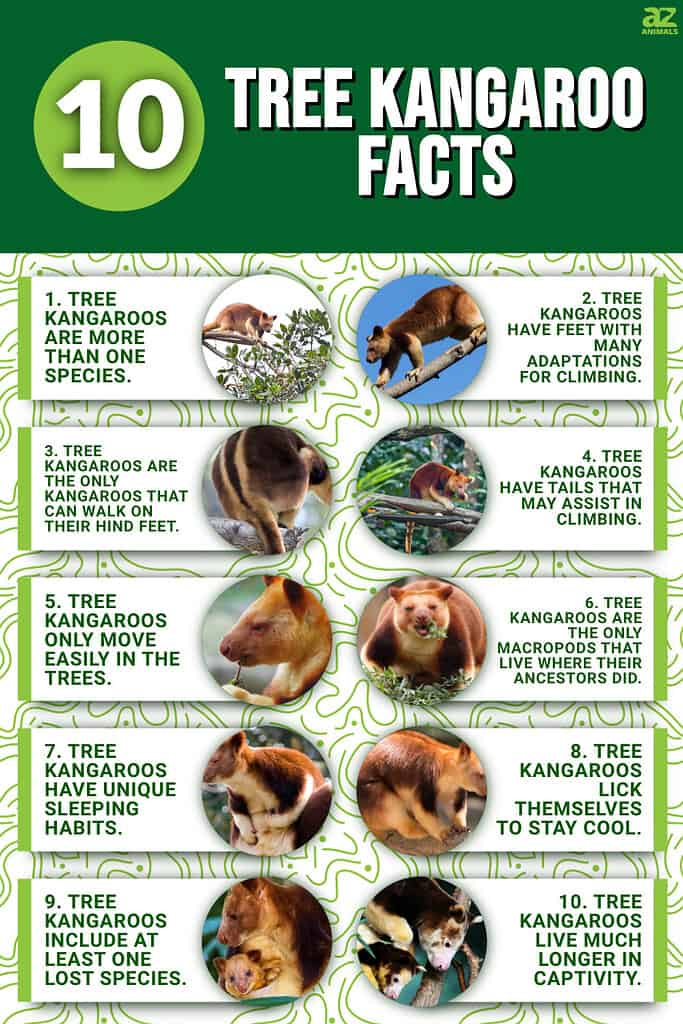
A tree kangaroo looks like a combination of a kangaroo and a lemur. They have strong forelimbs and short legs; their bodies have adapted well to the trees and are well-suited for climbing.
Whether you’re familiar with tree kangaroos or not, there is a lot about them worth knowing. Keep reading to learn 10 incredible tree kangaroo facts!
1. Tree kangaroos are more than one species.
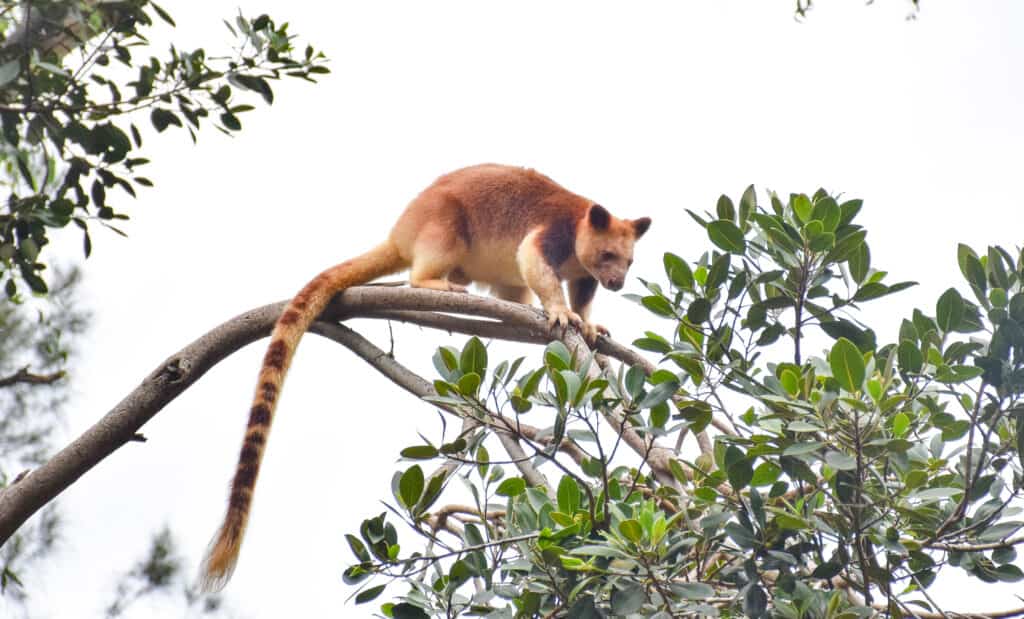
There are 14 different species of tree kangaroos.
©iStock.com/Phani Teja Duggirala
Most people would probably assume that tree kangaroos are a single species. However, this is not the case. They are actually a set of species within the genus Dendrolagus. There are 14 different species of tree kangaroos.
Tree kangaroo species vary in appearance. They can be black, gray, brown, or tan. The normal weight range for a tree kangaroo is anywhere from 13 to 33 pounds; they can also be anywhere from 19 to 36 inches tall.
The Lumholtz’s tree kangaroo is the smallest species of this genus, at 19 to 26 inches tall and weighing 13 to 16 pounds. The grizzled tree kangaroo, one of the largest species, can grow to be 29.5 to 35.5 inches in length and 18 to 33 pounds in weight.
2. Tree kangaroos have feet with many adaptations for climbing.
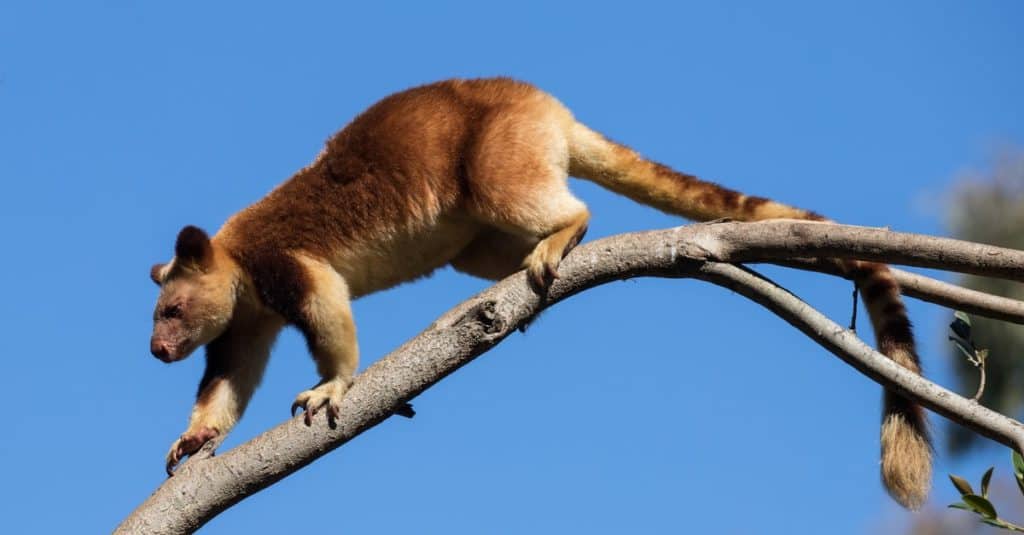
Tree kangaroos have many foot adaptations that assist with climbing, including broad hind feet, modified ankle joints, and sponge-like grips on their feet.
©Ken Griffiths/Shutterstock.com
Since climbing is a big part of the lifestyle of the tree kangaroo, it makes sense that their feet would be tailored to the process.
One example is that their hind feet are broader and longer than their front feet. This allows tree kangaroos to balance well and grab tree branches with ease. They also have longer legs than their terrestrial counterparts.
Tree kangaroos have modified ankle joints, allowing them to rotate their feet while climbing. They also have a sponge-like grip on their paws and feet, unique to tree kangaroos. Tree kangaroos have small bumps on their foot pads that help them grip.
3. Tree kangaroos are the only kangaroos that can walk on their hind feet.
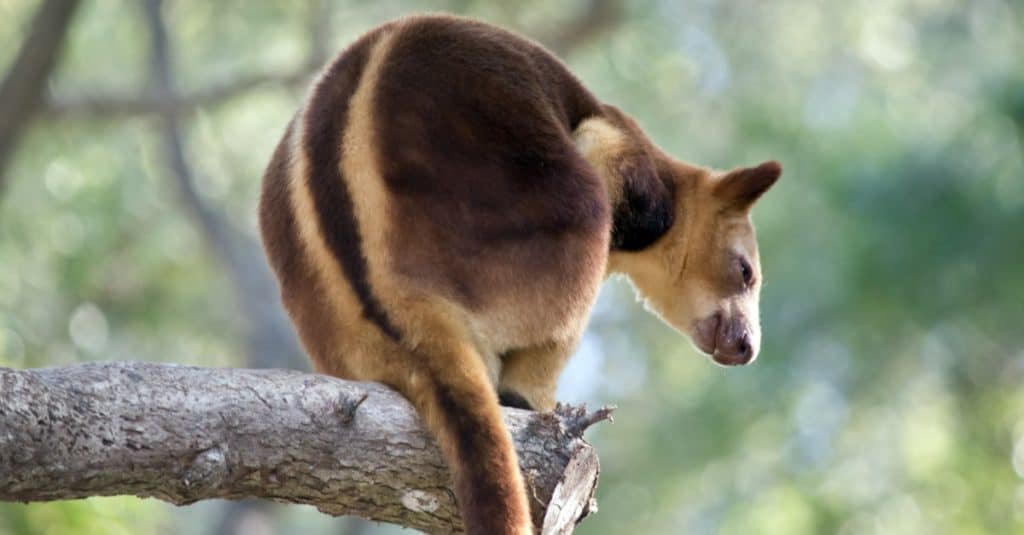
While ground kangaroos hop on their hind legs, tree kangaroos can actually move their hind feet independently of one another.
©Susan Flashman/Shutterstock.com
Most people think of terrestrial kangaroos as creatures that hop a lot. It is thought that tree kangaroos are the only kangaroos that are capable of moving their hind feet independently of one another. Other kangaroos are able to do this while swimming, but not on land.
Tree kangaroos can hop on two feet, bound on all four feet, and walk on two feet, whether they are in the trees or on the ground.
4. Tree kangaroos have tails that may assist in climbing.
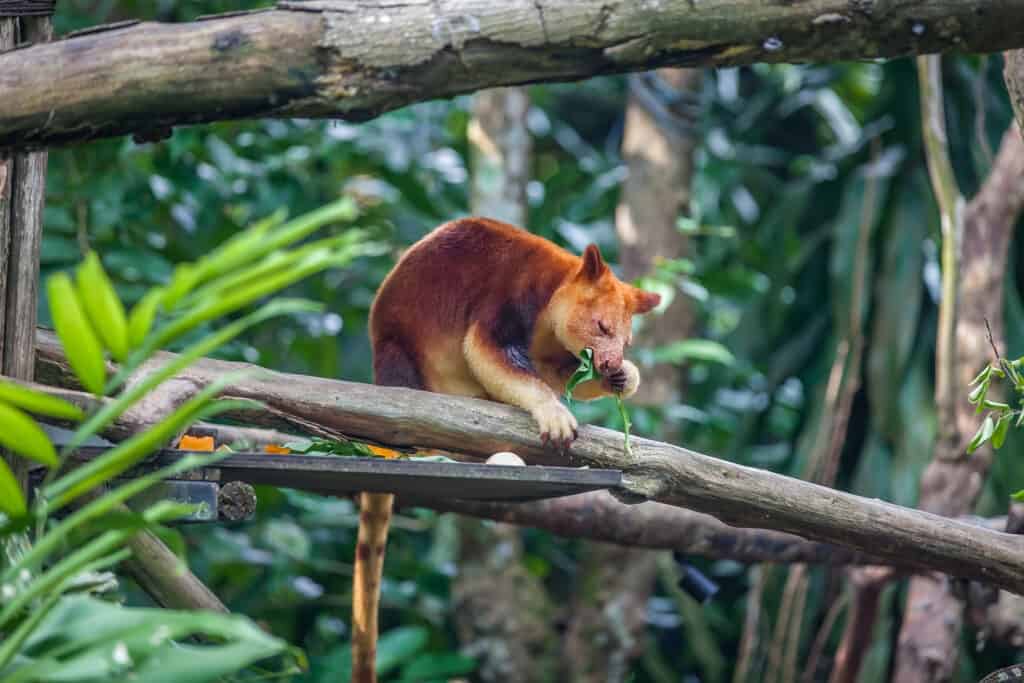
The tail of a tree kangaroo may assist its balance while tree-climbing.
©iStock.com/molishka1988
Compared to terrestrial kangaroos, tree kangaroos have a much bigger and more pendulous tail. Many believe that the tail of a tree kangaroo assists with balance while climbing.
However, this adaptation is not quite perfect. The tail of a tree kangaroo is often very long, sometimes up to 15% longer than the animal’s body. These tails dangle and often get in the way of the animal’s climbing.
5. Tree kangaroos only move easily in the trees.

Tree kangaroos can move with ease in the trees, but they are clumsy on the ground.
©Andreas Ruhz/Shutterstock.com
In the trees, tree kangaroos are some of the most impressive acrobats you will ever see. They can leap distances of up to 30 feet between trees and jump to the ground from 60 feet in the air without getting injured.
However, their movements are not nearly as impressive on the ground. On land, tree kangaroos are noticeably slow and clumsy. They can only jump slowly and with their tails erect.
6. Tree kangaroos are the only macropods that live where their ancestors did.
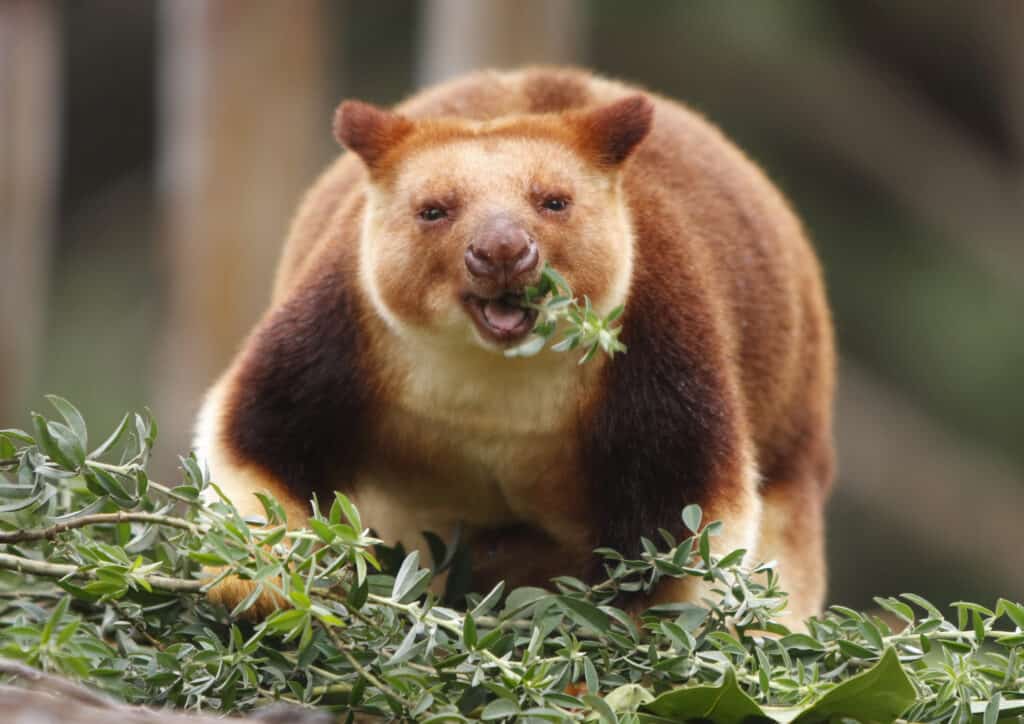
Millions of years ago, most macropods migrated to the ground except for tree kangaroos, making them the only true arboreal macropods.
©iStock.com/CraigRJD
All macropods, including different types of kangaroos and wallabies, used to live in the trees. However, millions of years ago, they migrated to the ground. Ancestors of today’s tree kangaroos eventually went back up into the trees.
Tree kangaroos are the only true arboreal macropods. Over time, they have acquired many adaptations that have made them well-suited for arboreal locomotion.
7. Tree kangaroos have unique sleeping habits.

Tree kangaroos sleep about 60% of the time, usually on a tree branch where they feel comfortable.
©Tim Williams / CC BY 2.0 – License
This group of marsupials sleeps about 60% of the time. However, despite a large amount of sleep, they don’t build nests for this purpose. They just sleep wherever they feel comfortable, typically on a tree branch.
8. Tree kangaroos lick themselves to stay cool.
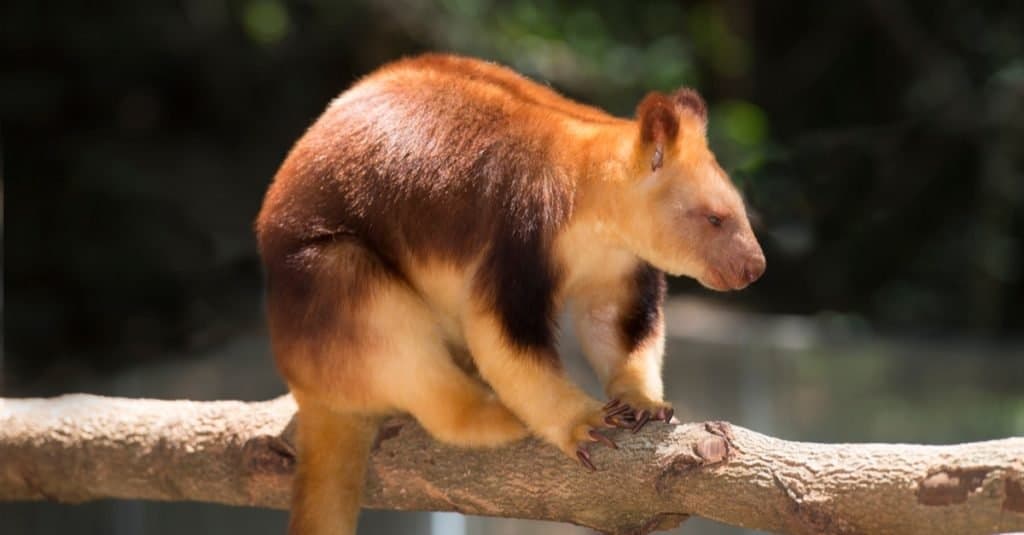
In warmer weather, tree kangaroos lick the fur of their forearms to keep cool.
©John Carnemolla/Shutterstock.com
When the weather is warm, tree kangaroos lick the fur on their forearms in order to lower their overall body temperature.
Kangaroos (including tree kangaroos) have networks of hundreds of tiny blood vessels that lie just under the surface of the skin on their forearms. When they lick their forearms, the moisture evaporates and draws heat from this vessel-rich area. Ultimately, it cools them down by cooling their warm blood.
9. Tree kangaroos include at least one lost species.
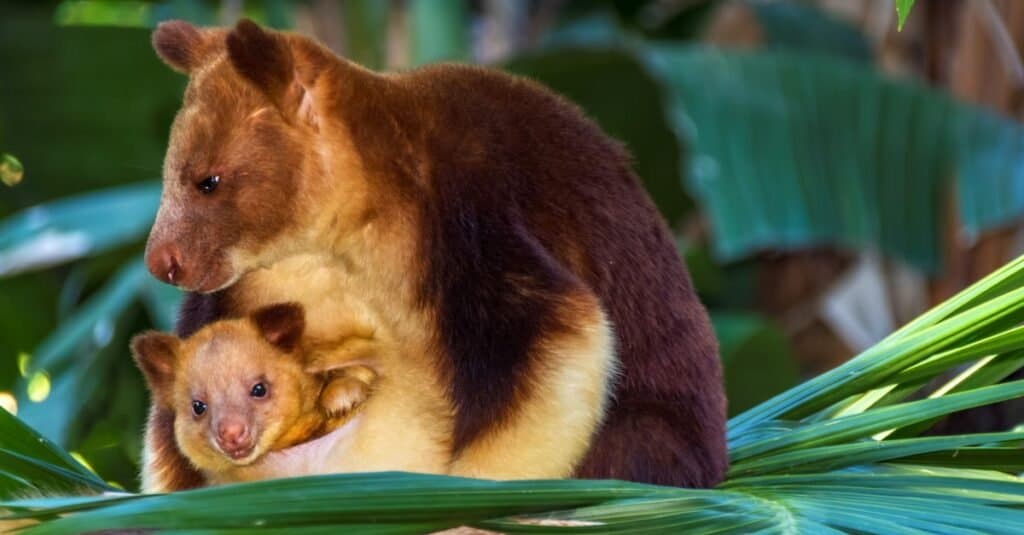
Of the 14 known species of tree kangaroos, the Wondiwoi tree kangaroo (not pictured above) is a lost species, and experts aren’t sure if it’s extinct or not.
©imagevixen/Shutterstock.com
The Wondiwoi tree kangaroo is considered to be a lost species. In fact, it is among the 25 most-wanted lost species in the Global Wildlife Conservation’s “Search for Lost Species” initiative. This is a list of endangered species, some of which have not been seen in several years.
No one knows for sure whether there are still any members of these species, or whether they are extinct.
While visiting Papua New Guinea, a tourist took somewhat grainy pictures of what could be a Wondiwoi tree kangaroo. However, to this day, no one is sure that that’s what it was. If it is confirmed, this will be the first time this particular tree kangaroo has been seen since before the 1930s.
10. Tree kangaroos live much longer in captivity.
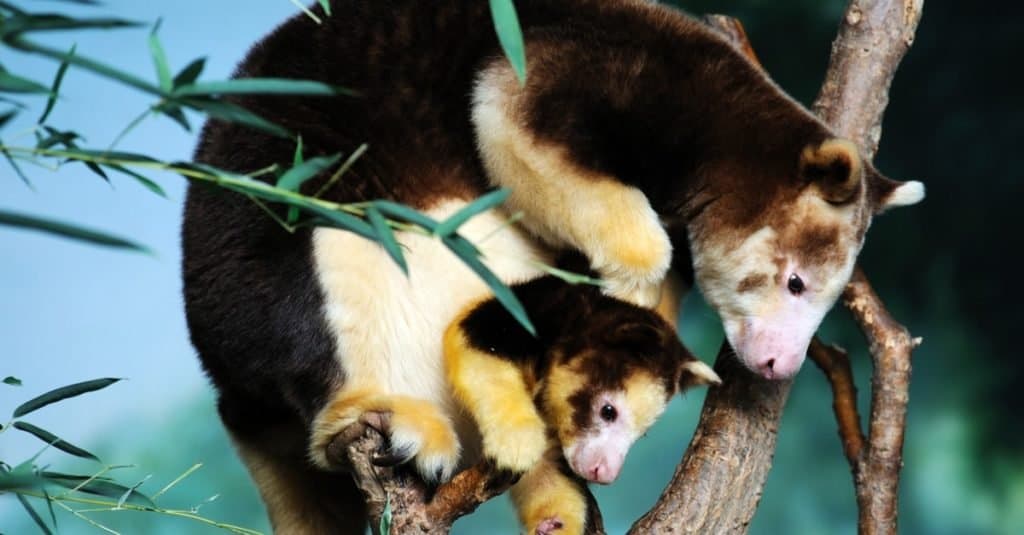
Every species of tree kangaroo is vulnerable, endangered, or critically endangered.
©Michael Jacob Photography/Shutterstock.com
Though tree kangaroos have natural enemies, including pythons and wild dogs, the two biggest threats to this species are hunting and habitat destruction.
Tree kangaroos are an important part of the diet and culture of indigenous people. As a result, these people often hunt them for their meat and fur, which threatens the survival of the species.
Additionally, their habitats are often replaced or destroyed by loggers, timber workers, and people who are involved with the production of rice, wheat, and coffee.
Tree kangaroos have lost more than 90% of their natural habitat space in the last three decades. The population has gone down by 80% in that time. Every species of tree kangaroo is considered to be vulnerable, endangered, or critically endangered.
Because of these threats to the species, the average lifespan of a tree kangaroo in the wild is only six to 15 years; meanwhile, they can live up to 27 years in captivity.
The photo featured at the top of this post is © iStock.com/CraigRJD
Thank you for reading! Have some feedback for us? Contact the AZ Animals editorial team.






